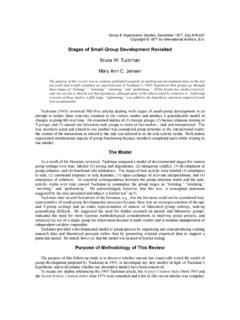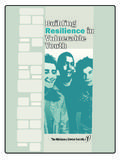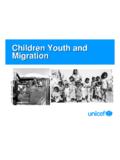Transcription of What Is Positive Youth Development? - WIU
1 What Is Positive Youth development ? By WILLIAM DAMON This article explores the recent approach to Youth research and practice that has been called Positive Youth development . The author makes the case that the approach grew out of dissatisfaction with a predominant view that underestimated the true capacities of young people by focusing on their deficits rather than their developmental potentials. The article examines three areas of research that have been transformed by the pos- itive Youth approach: the nature of the child; the interac- tion between the child and the community; and moral growth. It concludes with the point that Positive Youth development does not simply mean an examination of anything that appears to be beneficial for young people. Rather, it is an approach with strong defining assump- tions about what is important to look at if we are to accu- rately capture the full potential of all young people to learn and thrive in the diverse settings where they live.
2 Keywords: identity; resilience; moral emotion; com- munity-child relations E very child has talents, strengths, and inter- ests that offer the child potential for a bright future. The field of Positive Youth devel- opment focuses on each and every child's unique talents, strengths, interests, and future potential. William Damon is a professor of education and the direc- tor of the Center on Adolescence at Stanford University. He is a senior fellow at the Hoover Institution on War, Revolution and Peace. He has written widely on moral commitment at all ages of human life. Damon's books include The Moral Child (1990); Some Do Care: Con- temporary Lives of Moral Commitment (1992); Greater Expectations: Overcoming the Culture on Indulgence in Our Homes and Schools (1995); The Youth Charter: How Communities Can Raise Standards for All Our Children (1997); Good Work: When Ethics and Excel- lence Meet (2001); and Noble Purpose (2003). He is edi- tor-in-chiefof New Directions for Child and Adolescent development and editor-in-chief of The Handbook of Child Psychology.
3 NOTE: "What Is Positive Youth development ?" is copy- right ? William Damon, 2004. Requests concerning the further use or reproduction of this article should be directed to the author. DOI: ANNALS, AAPSS, 591, January2004 13 14 THE ANNALS OF THE AMERICAN ACADEMY Positive Youth development contrasts with approaches that have focused on problems that some young people encounter while growing up-problems such as learning disabilities; affective disorders; antisocial conduct; low motivation and achievement; drinking, drug use, or smoking; psychosocial crises triggered by maturational episodes such as puberty; and risks of neglect, abuse, and economic deprivation that plague certain populations. Models of Youth that focus on such problems have long held sway in the child care professions, the mass media, and the public mind. In such models, Youth is seen as a period fraught with hazards, and many young people are seen as potential problems that must be straightened out before they can do serious harm to themselves or to others.
4 This problem-centered vision of Youth has dominated most of the professional fields charged with raising the young. In education and pediatric medicine, for example, a huge share of resources has been directed to remediating the incapacities of young people with syndromes such as attention-deficit/hyperactivity disorder. In child psychology, intense atten- tion has been directed to self-esteem deficits, especially among girls; to damage created by childhood traumata such as poverty, abuse, and early separation; and to destructive patterns such as violence and aggression. Phrases such as "the at-risk child," "the learning-disabled child," "the juvenile delinquent," "the bully," "the man girl," and even "the super-predator" have filled professional journals as well as the popular press. The old suspicion that there are bad seeds, or (switching meta- phors) that there are rotten apples that will spoil the barrel if not removed in time, has been kept alive in the guise of scientific theories that propose a genetic deter- minism for Youth crime.
5 The job of Youth professionals has been seen to be identi- fying the problem early enough to defray and then patch up the damage. This focus on problems and deficits is part of a mental-health model left over from the work of child psychoanalysts such as Fritz Redl (Redl and Wineman 1951). It is also drawn from a criminal-justice model that has stressed punishment over prevention. One of the legacies of this problem- Youth tradition has been its influence on the way young people have been portrayed in the mass culture and, as a consequence, in the popular mind. It is well-known that the media portray young people in a consistently negative fashion. When adolescents appear on local television news, it is often in the guise of a criminal or other kind of miscreant. The following is a release titled "The Media Watches Kids," from The Communitarian Network Update of December 1, 2000. The release cited some data collected in October 2000 by Media Monitor, an inde- pendent Washington-based research center.
6 "According to a recent examination of a month of network and local TV news coverage of American Youth .., .just 2% of teenagers were shown at home, while only 1% were portrayed in a work setting. In contrast, the criminal justice system accounted for nearly 1 out of every 5 visual backdrops." (Communitarian Network 2000). Nothing has changed in the years since this observation was made; in fact, many media observers believe that the situation has gotten worse. WHAT IS Positive Youth development ? 15 The Positive Youth development Approach Partly as a reaction to media distortions such as those noted above, during the past decade, a new approach to Youth development has introduced a more affirma- tive and welcome vision of young people. This new approach envisions young peo- ple as resources rather than as problems for society. The Positive Youth develop- ment perspective emphasizes the manifest potentialities rather than the supposed incapacities of young people-including young people from the most disadvan- taged backgrounds and those with the most troubled histories.
7 While the Positive Youth development approach recognizes the existence of adversities and developmental challenges that may affect children in various ways, it resists conceiving of the developmental process mainly as an effort to overcome deficits and risk. Instead, it begins with a vision of a fully able child eager to explore the world, gain competence, and acquire the capacity to contribute importantly to the world. The Positive Youth development approach aims at understanding, edu- cating, and engaging children in productive activities rather than at correcting, curing, or treating them for maladaptive tendencies or so-called disabilities. The radical change brought about by this shift to a more Positive vision of Youth potential has taken place in a number of research areas. In each area, concepts that clearly were not valid have been discarded and replaced with ideas that have reversed the old way of thinking. This alteration in perspective has transformed the questions that researchers are asking, the insights that they have been able to dis- cover in their research, and the practice recommendations that have been imple- mented in all varieties of Youth -related work, from education to social policy.
8 I will organize this article around the following areas in this radical transforma- tion: (1) the nature of the child; (2) the manner in which young people interact with their communities as they grow up; and (3) the way in which young people work out their moral identities and perspectives on society and their present and future roles in it. The Nature of the Child Are children by nature hardy or delicate? The popular mind is split about this, reflecting generational or cohort differences. Young parents who worry about their children often find themselves reassured by a grandmother (real or apocryphal) who counsels "Don't worry, kids are resilient." This advice may reflect the grand- mother's greater experience, or it may reflect a modern trend toward increased child centeredness, in contrast to the more traditional view that young people are capable of bearing life's burdens without breaking (Damon 1995). Despite the familiarity of "grandmotherthly" folk wisdom about the hardiness of children, psychology has tended to promote a more modern vision of children as fragile, easily traumatized, and vulnerable to a host of dangers.
9 Some of these dan- 16 THE ANNALS OF THE AMERICAN ACADEMY gers are seen to threaten particular populations of children-the poor, the abused, the neglected-but others are seen to arise from the fabric of everyday experience: separation from parents, failure to master difficult tasks, puberty, transitions to new school environments, and so on. From the perspective of many child psychol- ogists, it seems that the very processes of living and growing place children at risk, and to make matters worse, children are by nature easily wounded by such psychological challenges. The first body of psychological research to directly contest this fragile child assumption came out of a series of longitudinal studies conducted in the 1980s. In one study, Norman Garmezy (1983) introduced the notion of the invulnerable child. Some-not all, but some-of Garmezy's research subjects showed resis- tance to life's most severe stressors, flourishing in spite of every prediction to the contrary.
10 In a cross-cultural study conducted in Hawaii and the mainland United States, Emily Werner (1982) found much the same thing. Werner adopted the clas- sic term resiliency to describe the quality that enables many young people to thrive in the face of any adversity. In a monograph that became enormously influential in the practice-oriented sectors of the Youth - development field, Bonnie Benard (1991) extended Werner's findings to virtually all young people, making the claim that every child possesses the potential to develop resiliency. Benard wrote that resilience is simply one of a cluster of adaptive response patterns that can be learned by anyone during childhood. Associated with resilience, according to Benard, are persistence, hopefulness, hardiness, goal directedness, healthy expec- tations, success orientation, achievement motivation, educational aspirations, a belief in the future, a sense of anticipation, a sense of purpose, and a sense of coher- ence.

















